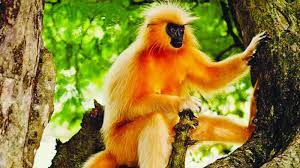07 Feb 2022 Golden Langur Habitat

- Villagers of Assam are protesting against the tag of a sanctuary for a ‘Golden Langur Habitat’.
Conflict:
- The Assam Forest Department had issued a preliminary notification to convert 19.85 sq km of forest into ‘Kakoijna Bamuni Hill Wildlife Sanctuary’.
- Kakoijna Reserve Forest is very famous for the Golden Langur.
- Villagers have demanded that the ‘traditional idea of wildlife sanctuary’ be dropped and the reserve forest be converted into a community forest resource by using the Forest Rights Act, 2006, so that the community co-participates for sustainable conservation. Managed system to be ensured.
- Villagers reported that the conservation efforts of the local people have helped the concerned authorities to reduce the forest canopy from 5% to 70% in almost three decades and increase the population of ‘Golden Swarna Langur’ from 100 to 600.
Difference between Wildlife Sanctuary, Reserved Forest and Community Forest Resource:
- Wildlife Sanctuary: This is the place which is specially reserved for the use of wildlife, in which animals, reptiles, insects, birds etc. are present. Its purpose is to provide wildlife with a place where they can keep their populations viable for a lifetime.
- The Wildlife Protection Act, 1972 empowers the central and state governments to declare any area as a wildlife sanctuary or a national park.
- Reserved Forests: Reserved forests are the most restricted forests and are created by the state government on any forest land or barren land that is the property of the government. The movement of local people is prohibited in the reserved forests without the special permission of any forest officer.
- Community Forest Resources: As per section 2(a) of the Forest Rights Act, these are the resources existing in common forest lands within the traditional or customary boundaries of the village where communities have traditional access to forests and protected areas such as sanctuaries and national parks.
About Golden Langur:
Scientific name: Trachypithecus geei
- Golden langurs can be identified by the color of their fur, after which they are named.
- It has been observed that their fur changes color according to the season as well as the geographical location (the area they live in).
- Their coloration in puberty also differs from that of adults as they are almost pure white.
- They are highly dependent on trees with upper canopy in the forests. They are also known as leaf monkeys.
- Habitat: It is found in western Assam and areas along the Indo-Bhutan border.
- Their habitat is confined to an area surrounded by four geographical sites: Bhutan (North), the Manas River (East), the Sankosh River (West), and the foothills of the Brahmaputra River (South).
To risk:
- Restricted Habitat: As mentioned above, their habitats are restricted by natural limits and they are heading towards extinction.
- Habitat fragmentation: Their habitat in Assam has been largely fragmented, especially after rural electrification and large-scale deforestation.
- Inbreeding: Constraints such as lack of dense forests due to deforestation have increased the risk of inbreeding in golden langurs.
Conservation Efforts:
- The Central Zoo Authority, New Delhi in 2011 entrusted a project to the state zoo for conservation, breeding of golden langur in Assam.
- In the year 2009, their estimated number in Assam was 5,140. The census could not be completed in 2020 due to the Kovid-19 lockdown.
Protection Status:
- Schedule I species under the Wildlife Protection Act (1972).
- Listed in Appendix I of the Convention on International Trade in Wildlife and Flora (CITES).
- This species has been kept in the category of Endangered in the IUCN Red List.


No Comments